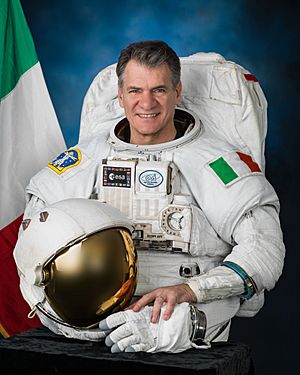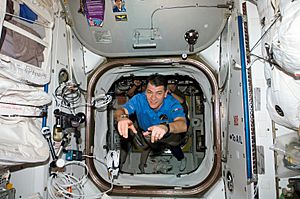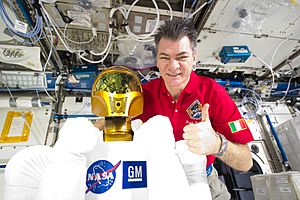Paolo Nespoli facts for kids
Quick facts for kids
Paolo A. Nespoli
OMRI
|
|
|---|---|
 |
|
| Born | 6 April 1957 Milan, Italy
|
| Status | Retired |
| Nationality | Italian |
| Occupation | Italian Army |
| Space career | |
| ESA astronaut | |
|
Time in space
|
313 days 2 hours 36 minutes |
| Selection | 1998 ESA Group |
| Missions | STS-120, Soyuz TMA-20 (Expedition 26/27), Soyuz MS-05 (Expedition 52/53) |
|
Mission insignia
|
|
Paolo Angelo Nespoli, born on April 6, 1957, is a famous Italian astronaut and engineer. He worked for the European Space Agency (ESA). Paolo Nespoli has traveled to space three times. His first trip was in 2007 on the Space Shuttle Discovery. He also flew on the Soyuz spacecraft in 2010 and 2017. He retired in 2019 after being ESA's oldest active astronaut.
Contents
About Paolo Nespoli
Paolo Nespoli grew up in Verano Brianza, a town in northern Italy. He is married to Alexandra Ryabova. They have a daughter and a son. Paolo enjoys many hobbies. These include scuba diving, flying planes, and photography. He also likes building electronic equipment and computer software. He is a big fan of the Serie A football team Inter.
Education and Military Background
Paolo Nespoli studied aerospace engineering. He earned his bachelor's degree in 1988. He then received his master's degree in 1989. Both degrees were from Polytechnic University in New York.
Before becoming an astronaut, he joined the Italian Army in 1977. He became a master parachutist and an instructor. He also worked as a Special Forces operator.
Astronaut Career
In July 1998, Paolo Nespoli was chosen as an astronaut. This was for the Italian Space Agency (ASI). Soon after, the European Space Agency assigned him to train. He trained at NASA's Johnson Space Center in Houston, Texas.
In 2013, Nespoli took part in a special training. It was called ESA CAVES in Sardinia. He trained with other astronauts. They explored caves to prepare for space missions.
First Space Mission: STS-120

On October 23, 2007, Paolo Nespoli launched into space. He was on board STS-120. This mission went to the International Space Station. The Space Shuttle delivered the Harmony module. This module was built in Turin, Italy. Nespoli was a mission specialist. He stayed in space for over 15 days. During this mission, he worked on the Esperia mission for ESA.
Second Space Mission: MagISStra

Paolo Nespoli's second space trip was called 'MagISStra'. He served as a flight engineer. This was for Expedition 26 and Expedition 27. It was Europe's third six-month mission to the International Space Station (ISS).
He flew on the Soyuz TMA-20 spacecraft. It launched on December 15, 2010. He traveled with Russian cosmonaut Dmitri Kondratyev and NASA astronaut Catherine Coleman. They returned to Earth on May 24, 2011.
During this mission, Paolo helped with docking operations. They received Europe's second Automated Transfer Vehicle (ATV-2). This spacecraft delivered important supplies to the Station. He also filmed most of the 2011 documentary First Orbit. He is credited as its director of photography.
Nespoli also helped with the arrival of the second Japanese HII Transfer Vehicle (HTV-2). This uncrewed spacecraft resupplies the ISS. He was the main operator for connecting HTV-2 to the ISS. In May 2011, the Space Shuttle Endeavour delivered the Alpha Magnetic Spectrometer (AMS-02) to the ISS.
Sadly, Paolo's mother passed away on May 4, 2011. The crew observed a minute of silence for her.
Paolo Nespoli did many experiments on the Station. These included monitoring radiation. He also took part in educational activities. One was "Mission X: Train Like an Astronaut." This program helped children learn about health and nutrition. He also used ESA's new 3D camera to show images of the ISS.
When Paolo left the ISS on May 23, 2011, he took special pictures. He was able to photograph a Space Shuttle docked with the ISS. This was the first time such pictures were taken from a Russian Soyuz spacecraft.
Third Space Mission: VITA
Nespoli's third mission was part of Expedition 52 and Expedition 53. He launched on Soyuz MS-05 on July 28, 2017. His mission was named VITA. VITA stands for Vitality, Innovation, Technology, and Ability. In Italian, "vita" also means "life." This name reflected the science and technology needed for life in space. He also continued outreach activities. These included the European Astro Pi Challenge. This challenge lets students run their own code on Raspberry Pi computers on the ISS.
VITA Mission Logo
The VITA mission logo was designed by ESA, the Italian Space Agency, and Nespoli. The circle in the logo represents Earth. The main goals are linked by a symbol. This symbol is a new version of the infinity sign. It is called "Third paradise." Inside are a DNA strand for science, a book for education, and Earth for humanity. The colors of the logo represent the Italian flag.
Mission Highlights
During the VITA Mission, Nespoli completed over 60 experiments. He also recorded the first content made in space specifically for Wikipedia. In his first month, he filmed parts of the National Geographic Channel's show One Strange Rock. He filmed scenes with astronaut Peggy Whitson.
Nespoli returned to Earth on December 14, 2017. The Soyuz MS-05 landed after 138 days in space.
Awards and Honors
Paolo Nespoli has received several awards for his work:
- 2007 NASA Space Flight Medal
- 2007 Commendatore Ordine al Merito della Repubblica Italiana
- 2009 Cavaliere dell'Ordine della Stella della solidarietà italiana
- 2015 America Award from the Italy-USA Foundation
See also
 In Spanish: Paolo Nespoli para niños
In Spanish: Paolo Nespoli para niños

